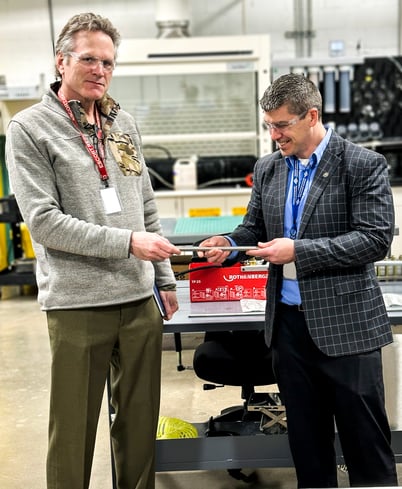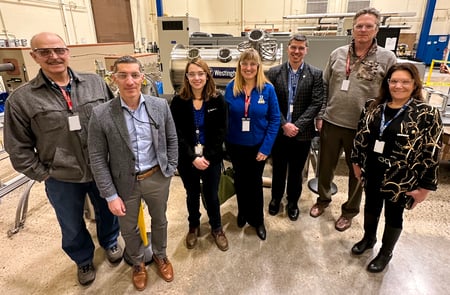Throughout its history, Alaska has been known as a land of boundless possibilities, adventure, exploration, natural resources and, of course, a strong cultural heritage tied to the indigenous communities who have called this land home for centuries.

Alaska Gov. Mike Dunleavy (left) views a sample heat pipe manufactured at the Westinghouse Waltz Mill research facility. The actual heat pipes for the nuclear test reactor are 12-feet in length.
Moving forward, Alaska sees a potential for nuclear energy technology to help the state secure its future by providing clean, cost-competitive, reliable and safe electricity, even to the most remote and harshest corners of the state.
It is a state with a lot of land — in fact the largest (you could fit Texas twice over in its 586,000 square miles) — but with the third smallest population. That creates a rather unique situation as many small rural communities search for sustainable sources of energy to thrive.
“We have more microgrids than anywhere else in the country, perhaps, possibly, the world,” said Alaska Governor Mike Dunleavy. “A lot of isolated communities, sometimes hundreds and hundreds of miles apart from each other, and currently most of those communities are dependent on diesel generation.”
Earlier this month, Westinghouse Electric Company welcomed Gov. Dunleavy, Alaska State Senator Click Bishop, and Gwen Holdmann, Director of the Alaska Center for Energy and Power, to its eVinci™ microreactor research and development facility at Waltz Mill, PA. The purpose of the visit was to learn more about how this game-changing technology could provide a sustainable clean energy future for Alaskans and support economic development opportunities for mining and other industries in the state.
“Alaska, we believe, is tailor-made for a technology like eVinci,” said Eddie Saab, vice president of new plant market development for Westinghouse, who attended the governor’s visit. “The key is eVinci’s transportability, which allows it to benefit remote communities that are off the grid, and industries such as mining operations that rely on diesel fuel for heat and electricity, which can be expensive and difficult to transport year-round.”
Gov. Dunleavy agrees. He says communities relying on diesel can pay $0.70 or more per kilowatt hour of electricity, due in part to the high cost of shipping the fuel by barge, truck or plane to these communities. “That’s really not a long-term solution for our people,” the governor said.
A True Nuclear Battery
eVinci operates much like a battery. It has almost no moving parts, is designed to supply power continuously for 8-plus years without refueling, and uses no water. Like a battery, it requires little operator interaction. Once delivered to a site and installed, eVinci will simply produce its electricity and heat until the fuel is depleted. When that occurs, a new module can be delivered and installed. The used module will be transported off-site for refurbishment at Westinghouse facilities. No spent fuel remains on site for long-term storage.
“The point is to make things simple,” said Saab. “To efficiently deliver this energy resource, install it in about 30 days, and let it run.”
That reliability is important for critical industries dependent on readily available electricity and heat, industries that can’t afford seasonal disruptions to their energy supply. Many of those industries reside in Alaska and Canada.

Gov. Dunleavy with some of the Westinghouse eVinci team at Waltz Mill. They are joined by State Senator Click Bishop (at left), Gwen Holdmann, Director of the Alaska Center for Energy and Power (center) and Westinghouse Alaska consultant Mary Ann Pease (at right).
A Solution for Alaska
The governor says microreactor technology, as well as energy storage, can help move communities away from diesel for electricity and build a sustainable future. Another application the governor sees as helpful to Alaska residents is the district heating capability of microreactor technology. The eVinci provides “free” low-grade heat at up to 200° Celsius to heat homes and businesses.
To help enable development of this technology, the Alaska legislature passed Senate Bill 177 last year, legislation put forward by the governor, who then signed it into law. It directs the Department of Environmental Conservation to begin creating the framework for eventually issuing permits for microreactors.
“Over the past four years, there have been legislative hearings on microreactors. With more to come,” said State Senator Click Bishop, who toured the Waltz Mill facility with Gov. Dunleavy. “There will be continued efforts by Alaska legislators to learn more about microreactors by touring sites such as the Westinghouse facility in Pennsylvania and Idaho National Laboratory.”
For Sen. Bishop, there is another reason for Alaska to pursue microreactor technology, about $1 billion in deferred operations and maintenance related to fuel storage.
“Microreactors in communities, where applicable, will go a long way to lowering energy costs, especially in remote places in rural Alaska,” Sen. Bishop said.
Saab says visits such as this are important as eVinci moves through the development process to deployment in the 2027-2028 timeframe.
“We know this technology is the right solution, but it is vital to listen to stakeholders to learn about the situations they are facing and understand exactly how we can meet their needs. Cooperation and consultation is key to successful deployment,” Saab said.


